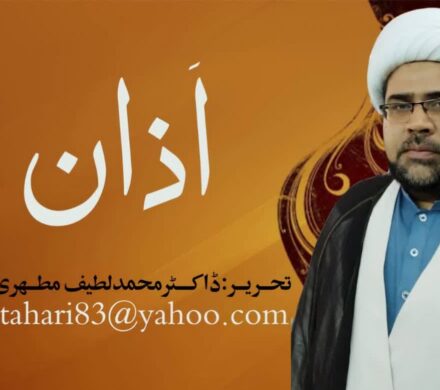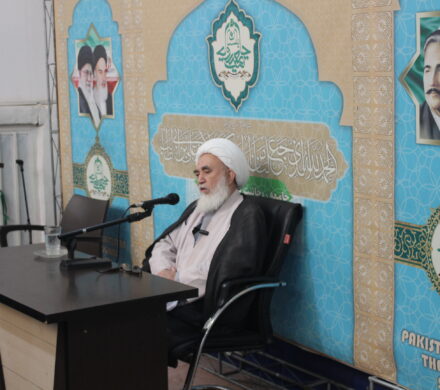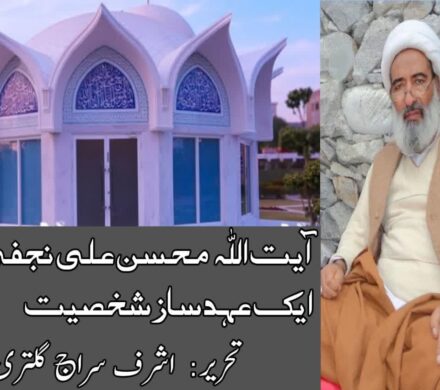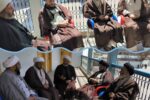The Position of Lady Fatima al-Zahra (a) in the Verse of Mubahalah1 from a Sunni Perspective
The Position of Lady Fatima al-Zahra (a) in the Verse of Mubahalah1 from a Sunni Perspective Muhammad Ya‘qūb Bashovi Translated by Seyyedeh Zahra Mirfendereski Abstract The verse of Mubahalah indicates the infallibility of the People of the Cloak (Ahzab-e Kisa) in their words and deeds. This verse refers to the famous event of al-Mubahalah which […]

 The Position of Lady Fatima al-Zahra (a) in the Verse of Mubahalah1 from a Sunni Perspective
The Position of Lady Fatima al-Zahra (a) in the Verse of Mubahalah1 from a Sunni Perspective
Muhammad Ya‘qūb Bashovi
Translated by Seyyedeh Zahra Mirfendereski
Abstract
The verse of Mubahalah indicates the infallibility of the People of the Cloak (Ahzab-e Kisa) in their words and deeds. This verse refers to the famous event of al-Mubahalah which took place in the year 10 A.H. against the Christians of Najran. Both Shi‘a and Sunni scholars have narrated this event. Imam Ali (a) was considered as ‘our souls’ (anfusana), Lady Fatima (a) as ‘our women’ (nisa‘ana), and Imam Hasan (a) and Imam Husayn (a) as ‘our sons’ (abna’ana). Some Sunni scholars believe that this report is fully authentic. Traditions about Mubahalah have been reported in 51 different ways and quoted from 37 major religious scholars.
Introduction
The interpretation of verses on the high status of Lady Fatima are found in both Shi‘a and Sunni traditional and exegetical sources. According to Sunni traditional and exegetical sources, more than 135 verses in 49 chapters and two complete chapters (Dahr and Kawthar) are related to Lady Fatima’s persona.
Verses interpreted concerning Lady Fatima (a) in Shi‘a sources are not included in these numbers, demonstrating the abundance of verses with reference to her. Among her titles include Ummi Abiha3 (or ‘the mother of her father’), the great woman of all women4, Kawthar5 (‘abundance’) in the Qur’an, and a piece of the Prophet’s (s) heart.6
Hundreds of related verses and many exegetical traditions in both Shi‘a and Sunni sources indicate infallibility, purity, honesty, self-devotion, sincerity, and other spiritual excellences of Lady Fatima (a).
However, her character still remains unknown; she is the one whose pleasure is a sign of Allah’s pleasure and whose wrath is a sign of Allah’s wrath. Truly, no pen can bear the burden of writing about the different dimensions of her character. Therefore, from among many verses revealed about Lady Fatima (a), the only verse discussed in this article is the verse of Mubahalah from a Sunni point of view.
The verse of Mubahalah
فَمَن حَآجّکَ فِیهِ من بَعدِ مَا جَآءَکَ مِنَ العِلم فَقُل تَعَالَوا نَدعوا أَبناَءَنا و أَبنآءَکُم وَ نِسآءَنا وَ نِسآئَکُم وَ أَنفُسَنا وَ أنفسکم ثمّ نَبتَهل فَنجَعَل اللَّهِ لَعَنةَ اللَّهِ علی الکَاذِبینَ
Should anyone argue with you concerning him, after the knowledge that has come to you, say, ‘Come! Let us call our sons and your sons, our women and your women, our selves and yourselves, then let us pray earnestly and call down Allah’s curse upon the liars.’ (Qur’an 3:61)
Literal meaning of Mubahalah
According to Jawhari7 (d. 393 A.H) in his Sihah al-Lughah, the term Mubahalah means ‘to curse each other’ and ibtihal,8 means ‘to pray to Allah (swt) earnestly’.9 Moreover, Ibn Faris (d. 395 A.H) in his Mu‘jam Maqa’is al-Lughah says: “b-h-l”10 has three meanings: a) to empty and set free, b) to invoke and pray fervently, and c) shortage of water.
The term Mubahalah and the verse of Mubahala11 (3:61) refers to the second meaning, that is, ‘to invoke and pray fervently’, because when two people engage in Mubahalah, one curses the other and begs Allah (swt) to punish the addressee.
Definition and incident of Mubahalah
Mubahalah occurs when one person or group invokes the curse of Allah (swt) on another person or group about a religious issue and they implore Allah to disgrace those who lie about it.
According to both Shi‘a and Sunni sources, a group of Christians from Najran went to the Prophet (s) and talked about Prophet Jesus (a). The next day when the Prophet (s) decided to do mubahalah, he chose Imam Ali (a) to represent the Muslims as ‘ourselves’, Lady Fatima (a) as ‘our women’, and Imam Hasan (a) and Imam Husayn (a) as ‘our sons’ from amongst all Muslims to confirm his prophethood. This act of the Prophet (s) is a proof for the infallibility and honesty of Lady Fatima al-Zahra (a).
Revelation of the verse of Mubahalah
‘Alba’ ibn Ahmad Alishkari says, “When the verse of Mubahalah (3:61) was revealed, the Prophet (s) called Ali (a), Lady Fatima (a), Hasan (a) and Husayn (a) and invited the Jews for Mubahalah.
As soon as a young man from among them was informed of the Prophet’s (s) suggestion, he told them, “Woe to you! Have you forgotten that your brothers were mutated into monkeys and pigs? Avoid Mubahalah, otherwise you would suffer the same.”12
Jabir ibn ‘Abdullah reports that the verse of Mubahalah is about Ali (a), Lady Fatima (a), Hasan (a) and Husayn (a). He believes that the word ‘ourselves’ refers to the noble Prophet (s) and Ali (a), ‘our sons’ refers to Hasan (a) and Husayn (a), and ‘our women’ refers to Lady Fatima (a).13
Sa‘d ibn Abi Waqqas reports: “When the verse of Mubahalah was sent down, the noble Prophet (s) summoned Ali (a), Lady Fatima (a), Hasan (a) and Husayn (a), and stated, ‘O Allah! These are my
household.’”14
The three above-mentioned traditions show that the verse of Mubahalah has been revealed concerning the People of the Cloak (Ashab-e Kisa’).
In his commentary, Al-Tafsir al-Kabir, Imam Fakhr Razi writes, “Once the Prophet (s) left his house toward the place of Mubahalah. As his black hair hung down to his shoulders, he (s) was carrying Husayn (a) on his shoulders – or cuddling him – and holding Hasan’s (a) hand. Lady Fatima (a) followed him and Ali (a) was behind her. When they reached their journey’s end, the Prophet (s) told them, ‘After each prayer of mine, say ‘Amen.’”
When the bishop of Najran saw this great scene, he said, “I see such faces that if they were to ask Allah (swt) to uproot mountains He (swt) would do so. O Christians! Avoid doing Mubahalah with this man, or you will be destroyed and not a single Christian will survive in the world until the day of Resurrection.”
Then the Prophet (s) said: “I [swear] by Allah (swt) to Whom my life belongs, if they did Mubahalah, they would have been destroyed. They would have been mutated into monkeys or pigs. A fire would occur in their land [Najran] and all its inhabitants, including the birds on the trees, would be consumed. Nothing would prevent destruction and all Christians would die.”15
The verse of Mubahalah according to Sunnis
The main part of the story, which is the fact that the Prophet (s) chose Ali (a) as ‘ourselves’, Lady Fatima (a) as ‘our women’, and Hasan and Husayn (a) as ‘our sons’ is accepted by all scholars of exegesis and hadith, as some Sunni exegetes such as Imam Fakhr Razi16 and Nizam al-Din Nayshaburi17 have confirmed it as well. Nayshaburi adds, “‘Ourselves’ refers to Ali (a) and the majority of scholars of exegesis and hadith have accepted it.”18
Imam Abu Bakr Jassas19 wrote: “All historians and narrators agree that on the day of Mubahalah, the Prophet (s) approached the Christians and invited them for Mubahalah while he (s) held Hasan and Husayn’s (a) hands and Ali (a) and Lady Fatima (a) accompanied him.”20
Hakim Nayshaburi21 believes that the story of Mubahalah has been narrated by successive transmitters and says, “It has been related in commentaries of Qur’an by successive transmitters such as ‘Abdullah ibn ‘Abbas that the Prophet (s) on the day of Mubahalah held Ali (a) and Hasan (a) and Husayn’s (a) hands and put Lady Fatima (a) behind them. Then he (s) called them “ourselves,’ ‘our sons,’ and ‘our women.’” 22
On the authenticity of the verse, Zamakhshari23 wrote, “There is no proof better than this [verse] that indicates the high status of People of the Cloak (Ahzab-e Kasa’) who are Ali (a), Lady Fatima (a), Hasan (a), and Husayn (a).”
Other Sunni scholars such as ibn Taymiyyah,24 ibn Kathir,25 ibn Yasin,26 Muhammad ibn Surah,27 ‘Abd al-Razzaq al-Mahdi28 and Hakim Niyshaburi29 have acknowledged the authenticity of the abovementioned hadiths.
The verse of Mubahalah indicates the greatness and honesty of Lady Fatima (a) and her high status in this world and the next. Alusi30 has also acknowledged the prominence of this hadith. He says, “The indication of this verse as to superiority of the family of His messenger (s) is a matter no faithful person doubts and [it is a fact that] hostility against the family of the Prophet (s) undermines one’s faith.”31
The unsurpassed greatness of Lady Fatima (a)
The Prophet (s) took only Lady Fatima (a) as ‘nisa’ana,’ ‘our women’ for Mubahalah in the presence of some of the wives of the Prophet (s). Nevertheless, he (s) took none of them for Mubahala. He (s) needed to take people with himself that could be his support on his prophetic mission, and Lady Fatima (a) was so.
If the Prophet (s) had taken with himself someone who had lied even once in his/her life he (s) could not have cursed liars, because if he had done se he would have cursed the one who was with him as well.
This elucidates Lady Fatima’s infallibility: she (a) was a perfect exemplar of honesty which confirms her high status and greatness. Even the bishop of Najran spoke of Lady Fatima’s (a) greatness to his people by saying, “I see such faces who if they were to ask God to uproot mountains and He would do so. O Christians! Avoid doing Mubahalah with this man, or you will be destroyed and even one Christian will no longer survive in this world.”32
The Prophet (s) took Lady Fatima (a) as a proof of his prophethood for Mubahalah. Before going to the meeting, he (s) gathered Ali (a), Lady Fatima (a), Hasan (a) and Husayn (a) together and said, “O Allah! These are my family.”33 Indeed, the Prophet (s) introduced his true household to the Muslims. Especially among women, it is Lady Fatima (a) who is meant to be “our women.”34
Transmitters of traditions of Mubahalah
The event of Mubahalah has been transmitted in 51 different ways,35 from 37 companions [of the Prophet (s)], followers of the companions, and household of the Prophet (s), including Imam Ali (a),36 Imam Hasan (a),37 Imam Ali ibn Husayn (a),38 Abi Ja‘far Muhammad ibn Ali al-Baqir (a),39 Imam abi ‘Abdullah Ja‘far ibn Muhammad al-Sadiq (a),40 and Imam Musa ibn Ja‘far (a).41 Companions, followers, and prominent people include: Ibn ‘Abbas,42 Jabir ibn ‘Abdullah,43 Sa‘d ibn abi Waqqas,44 Hudhayfah ibn Yaman,45
Abi Rafi‘ (slave of Prophet (s),46 ‘Uthman ibn ‘Affan,47 TalJ:ah ibn ‘Abdullah,48 Zubayr ibn al-‘Awam,49
‘Abd al-Rahman ibn ‘Awf,50 Bara’ ibn ‘Azib,51 Anas ibn Malik,52 Bakr ibn Mismar,53 Munkadir ibn ‘Abdullah from his father,54 Hasan Basri,55 Qutadah,56 Suddi,57 Ibn Zayd,58 ‘Alba’ ibn AJ:mar Alishkari,59 Zayd ibn Ali,60 Sha‘bi,61 Yahya ibn Ya‘mar,62 Mujahid ibn Jabr Makki,63 Shahr ibn Hawshab,64 Abi Tufayl ‘Amir ibn Wathilah,65 Jurayr ibn ‘Abdullah Sajistani,66 Abi Uways Madani,67 ‘Amr ibn Sa‘id ibn Ma‘adh,68 Abi al-Bakhtari,69 Abi Sa‘id,70 Salmah ibn ‘Abd Yashu’ from his father,71 and ‘Amir ibn Sa‘d.72
Arguments for the verse of Mubahalah
On the day of Shura (Consultation), Imam Ali (a) reminded the audience that the verse of Mubahalah has been sent down about him [and the rest of the household of the Prophet (s)].73
‘Amir ibn Sa‘d ibn Abi Waqqas has quoted from his father, “One day, Mu‘awiyah ibn Abi Sufyan ordered Sa‘d to curse Ali (a). Sa‘d disobeyed him. Mu‘awiyah asked him, “Why do you refuse to swear at Ali (a)?” Sa’d answered, “Once the Prophet said that Ali (a) possessed three attributes. So, I would never swear at him. If I had just one of them, I would count it better than having camels with red hair…”74
When the verse of Mubahalah was sent down, the Prophet (s) summoned Ali (a), Lady Fatima (a), Hasan (a) and Husayn (a) and said, ‘O Allah! These are my family.’”75
Imam Musa Kazim (a) used the verse of Mubahalah as a convincing argument when Harun al-Rashid protested.76
Objectors’ view
This section describes some of the objections on the significance of Mubahalah.
Ibn Taymiyyah’s view
Ibn Taymiyyah77 acknowledges that the Prophet (s) took Ali (a), Lady Fatima (a), Hasan (a) and Husayn (a) for Mubahalah and believes that it is an authentic hadith; however, he says he (s) took them because they were his closest relatives.78
Reply: If the Prophet (s) took them because they were just his close relatives, he (s) should have taken at least three persons of his relatives as ‘our souls’ (anfusana), since Sunnis believe that Ali was not the only son in law of the Prophet (s). He (s) could have also taken his wives as ‘our women,’ but he (s) took only Lady Fatima (a). In spite of the fact that ‘our women’ is a plural noun and includes at least three people, the noble Prophet (s) took only Lady Fatima (a).
On the other hand, ‘Abbas was a closer relative to the Prophet (s) than Ali (a), because he was the Prophet’s (s) uncle. Nevertheless, he (s) took Ali (a) and not ‘Abbas. Therefore, Ibn Taymiyyah’s view is not correct. The Prophet (s) chose his household because of their high spiritual status, and not because
of their relationship.
‘Abduh’s view
Muhammad ‘Abduh says: All hadiths and traditions agree unanimously that the Prophet (s) chose Ali (a), Lady Fatima (a) and their two sons for Mubahalah, and that “our women” meant Lady Fatima (a), and “ourselves” meant Ali (a). These Shi‘a traditions were spread among the Muslims; those who did so succeeded in their attempt spread them among the Sunnis as well. However, those who fabricated these hadiths could not reconcile their false traditions on the verse of Mubahalah. They argue that the word “nisa‘ana” – ‘our women’ – in the verse is a plural noun in Arabic, and Arabic-speaking people do not use this word for one woman, especially not for a woman who is the daughter of a narrator who has several wives.79
Reply: ‘Abduh has unfairly said that the source of traditions is the Shi‘as, although many Sunni exegetes and narrators of hadiths have reported this tradition in their commentaries and collections of hadiths and have acknowledged it, such as: Imam Ahmad ibn Hanbal (d. 241 A.H),80 Imam Muslim (d. 273 A.H),81 Muhammad ibn Surah (d. 279 A.H),82 Tabari (d. 310 A.H),83 Ibn abi Hatam (d. 375 A.H),84 Abu alFaraj Isfahani (d. 356 A.H),85 Imam Abu Bakr Jassas (d. 370 A.H),86 Samarqandi (d. 375 A.H),87 Hakim Nayshaburi (d. 405 A.H),88 Tha‘labi (d. 427 A.H)89, Mawardi (d. 450 A.H),90 Beyhaqi (d. 458 A.H),91 WaJ:idi (d. 468 A.H),92 Hakim Haskani (d. 471 A.H),93 Imam Baghawi (d. 516 A.H),94 Zamakhshari (d. 538 A.H),95 Ibn Qayyim al-Jawziyah,96 Ibn Jawzi (d. 597 A.H),97 Fakhr Razi (d. 604 A.H),98 Qurtubi (d. 671 A.H),99 MuJ:ib Tabari (d. 694 A.H),100 Nusufi (d. 710 A.H),101 Imam Khazin (d. 725 A.H),102 Ni’.am al-Din Nayshaburi (d. 728 A.H),103 Ibn Taymiyyah (d. 728 A.H),104 ‘Abd al-Wahhab Mitri (d. 733 A.H),105 Ibn Hayyan Andulusi (d. 745 A.H),106 Dhahabi (d. 748 A.H),107 Ibn Kathir (d. 744 A.H),108 BayIawi (d. 791 A.H),109 Ibn Hajar ‘Asqalani (d. 852 A.H),110 Suyuti (d. 911 A.H),111 Ibn Hijr Haythami (d. 973 A.H),112 Abi Sa‘ud (d. 982 A.H),113 Muhammad Ali Sabuni (d. 997 A.H),114 Buruswi (d. 1137 A.H),115 ‘Ijli (d. 1204 A.H),116 Ahmad ibn Muhammad ibn ‘Ujaybah (d. 1244 A.H),117 Alusi (d. 1270 A.H),118 Qasimi,119 Shawkani (d. 1250 A.H),120 Tantawi Jawhari,121 Miybudi,122 Hikmat ibn Yasin,123 Sa‘id Huwi,124 Sayyid Tantawi (Mufti of Egypt),125 Hasan al-Mansuri,126 Niyaz Qari,127 ‘Abd al-Qadir Al ‘Uqdah,128 Abu Bakr Jaza‘iri,129 and Sulayman Qunduzi Hanafi.130
These scholars and many other scholars of exegesis and hadith who have narrated this tradition in more than 51 different ways are among well-known Sunni scholars. No Sunni exegete, transmitter of hadiths, historian, scholar of rijal131 or criticism of traditions has claimed that this tradition is a fabrication. On the contrary, as it was mentioned before, some Sunni scholars have said that this tradition is accepted by all or majority of exegetes and traditionists and they believe that it has been narrated by successive transmitters.
Furthermore, the following statement of ‘Abduh’s is not true:
Those who fabricated this story could not reconcile it with the verse of Mubahalah, because when an
Arab hears the word of nisa’ana – which is a plural noun – does not imagine that the speaker might mean his own daughter, especially when the speaker has several wives.
Zamakhshari (d. 538 A.H), a literature scholar who has also written a commentary (tafsir) on Qur’an, has written the following:
This event is the most convincing proof of excellence of People of the Cloak (Ahzab-e Kisa’) and it is a clear evidence for the prophethood of the Prophet (s).132
How could it be possible that such men of letters [i.e the exegetes] and eloquence have not understood that [with that interpretation of the verse] they would have made a false claim about the glorious Qur’an, despite the fact that the Qur’an has used plural nouns referring to persons, e.g. in (3:45) we read:
When the angels said, ‘O Mary, Allah gives you the good news of a Word from Him
In this verse, “angels” is a plural noun that refers to one angel, i.e. Gabriel.133 Moreover, in the glorious Qur’an, the word of nisa’ana has been used for girls as well, e.g. in the verse 2:49, God says regarding Pharaoh says:
…and slaughtered your sons and spared your women…
Or in the verse 4:7, we read:
…and women have a share in the heritage left by parents and near relatives…
If the word nisa’ (women) could be used for girls, it makes no difference as to whether the girl is the speaker’s daughter or the addressee’s.
Rashd Ri(ia’s view
After reporting traditions of Mubahalah, Rashd RiIa’ writes:
Regarding the verse “…come! Let us call our sons and your sons…”, Ibn ‘Asakir narrates from Ja‘far ibn Muhammad (a) that he quoted his father (a) as saying, “The Prophet (s) took Abu Bakr and his son, ‘Umar and his son, and ‘Uthman and his son for Mubahalah and, apparently, he meant a group of Muslims.”134
Response: Ibn ‘Asakir has quoted this tradition from Imam Sadiq (a) through Sa‘d ibn ‘Anbasah and Haytham ibn ‘Uday.
About Sa‘d ibn ‘Anbasah, Abu Hatam Razi says, “He does not tell the truth.”135 ‘Abd al-Rahman says, “Once Ali ibn al-Husayn (a) stated, “Sa‘d ibn ‘Anbasah is a liar; I heard from my father that he does not tell the truth.”136 Also Yahya ibn Mu‘in says, “He is a liar.”137 Ibn Abi Hatam quotes from his father, “It is questionable.”138 In famous Sunni books of rijal, not only is there no compliment about him, but rather
he is strongly criticized and it is emphasized that he was a liar and rejected as a hadith narrator. Dhahab (d. 748 A.H),139 Ibn Jawzi140 and Ahmad ibn Hajar ‘Asqalani (d. 852 A.H)141 have acknowledged this issue.
About Haytham ibn ‘Uday, Bukhari said, “It is not the truth, he has lied”. In addition, Yahya has said the same about him. Abu Dawud said, “He is a liar.” Nisa’i called him, “A rejected hadith narrator.”142
Sa‘di said, “Haytham ibn ‘Uday is rejected.143 Yahya ibn Mu‘in said, “I asked my father about him, he answered: ‘he is a rejected hadith narrator’.”144 ‘Abbas al-Dawri said, “Some friends of us quoted from Haytham ibn ‘Uday’s handmaid. ‘There is no night except that my master gets up for praying, and when the morning comes, he lies!’”145 Basti said, “He narrates from trusted people important things…while he conceals some of them.”146 Bukhar (d. 256 A.H) is also quoted as saying that, “I keep silent about [do not quote from] him.”147 Azdi believed that he was a “rejected hadith narrator”.148 Ibn Habban is quoted as saying that, “It is not allowed to refer to or narrate from him unless there is another way to verify the hadith.”149
Some scholars such as Daraqtani,150 Dhahabi151 and ‘Aqili152 considered him as an unreliable and rejected hadith narrator. Therefore, the tradition he narrated is not authentic and it is not compatible with true and widely transmitted traditions and hence it should be rejected.
Conclusion
The verse of Mubahalah undeniably indicates the infallibility and honesty of Lady Fatima (a). It is remarkable that according to this verse, Lady Fatima (a) is not one person amongst nisa’ana (our women), but rather this word refers to Lady Fatima (a) exclusively153 as she was the sole person capable of fulfilling the qualifications of the verse.
1. 3:61
2. MA in Qur’an and hadith sciences from Imam Khomeini school
3. See: ‘Iz al-Din ibn Athir, Asad al-Ghabah fi Ma‘rifah al-Sahaba, Beirut, Dar Ihya’ al- Turath al-‘Arabi, vol. 5, p. 52.
4. See: Muhammad ibn Isma‘il Bukhari, Sahih al-Bukhari, Beirut, Dar al-Jayl, vol. 4, p. 248; Jalal al-Din Suyuti , al-Durr alManthur fi al-Tafsir al-Ma’thur, Dar al-Fikr, 1993, vol. 2, p.19.
5. Fakhr al-Din Razi, Al-Tafsir al-Kabir, Beirut, Dar al-Fikr, 1985, in the commentary of chapter of Kawthar.
6. Mahmud ibn Isma‘il Bukhari, Ibid, vol. 5, p. 36; Hakim Nayshaburi, al-Mustadrak ‘ala al-Sahihayn, Beirut, Dar alMa‘rifah, vol. 3, p. 158.
7. Abu Nasr Isma’il ibn Hammad al-Jawhari, the author of a notable Arabic dictionary
8. In Arabic, verbal noun of Mubahilah
9. Isma‘il Jawhari, Al-Sihah, Beirut, Dar al-‘Ilm li al-Mulla’in, 1987, under root form “b-h-l”.
10. In Arabic, past root of Mubahilah
11. Ahmad ibn Fars, Mu‘jam Maqayis al-Lughah, Beirut, Dar al-Kitab al-‘Arabiyyah, under root form “b-h-l”.
12. Muhammad ibn Jarir Tabari, Jami‘ al-Bayan ‘an Ta‘wil Ayat al-Qur’an, Dar al-Fikr, 1988, vol. 3, p. 301; Jalal al-Din Suyuti , Ibid, vol. 2, p. 233.
13. Jalal al-Din Suyuti , Ibid, vol. 2, p. 231; Isma‘il ibn Kathir Damishqi, Tafsir al-Qur’an al-‘Azim, Beirut, Dar al-Ma‘rifah, 1987, vol. 1, p. 379; Ali Wahidi, Asbab al-Nuzul, Riyadh, Dar al-Thaqafah al-Islamiyyah, 1984, pp. 90-91.
14. Muslim ibn Hajjaj Nayshaburi, Sahih Muslim, Sharh-e Nawawi, Beirut, Dar al-Qalam, 1987, vol.
15, p. 185; Muhammad ibn Surah, Sunan Tirmidhi, Beirut, Dar al-Fikr, 1994, vol. 5, p.407; Jalal al-Din Suyuti , Ibid, vol. 2, p. 233. 15. Fakhr Razi, Ibid, vol. 8, p. 89.
16. Ibid. d. 604 A.H
17. d. 728 A.H
18. Nizam al-Din Nayshaburi, Ghara‘ib al-Qur’an wa Ragha’ib al-Furqan, Beirut, Dar al-Kutub al-‘Ilmiyyah, 1996, vol. 2, p. 178.
19. d. 370 A.H
20. Ahmad Razi Jassas (d. 370 A.H), Ahzkam al-Qur’an, Mecca, al-Maktabah al-Tijariyyah, vol. 2, p. 23.
21. d. 405 A.H
22. Muhammad Hafiz Nayshaburi, Ma‘rifah al-‘Ulum al-Hadith, Beirut, Dar al-Kutub al- ‘Ilmiyyah, 1977, p. 50.
23. d. 538
24. Ibn Taymiyyah al-Harrani al-Damishqi, (d. 728 A.H) Minhaj al-Sunnah al-Nabaw1yyah fi Naqdi Kalam al-Sh1‘ah wa al-Qadr1yyah, Cairo, Maktabah ibn Taymiyyah, 1998, vol. 4, p. 35.
25. ‘Abd al-Rahman Razi, (d. 774 A.H.) Tafsir al-Qur’an al-‘Azim Sanadan ‘an Rasul Allah wa al-Sahaba wa al-Tabi‘in, Beirut, al-Maktabah al-Misriyyah, 1999, vol. 1, p. 421
26. Hikmah ibn Yasin, Al-Tafsir al-Sahih Mawsu‘ah al-Sahih al-Masbur min al-Tafsir bi al- Ma’thur, Medina, Dar al-Athar, 1999, vol. 1, p. 421.
27. Muhammad ibn Surah, (d. 279 A.H. )Ibid, vol. 5, p. 407.
28. Muhammad Shukani, Fathz al-Qadr al-Jami‘ fi fann al-Riwayah wa al-Dirayah min ‘Ilm al- Tafsir, vol. 1, p. 449. In its marginal note, the researcher of the book has acknowledged authenticity of the hadith related by Sa‘d.
29. Hakim Nayshaburi, Ibid, vol. 3, p. 150.
30. Mahmud Alusi, (d. 1270 A.H.)RuJ: al-Ma‘ani fi Tafsir al-Qur’an al-‘Azim wa al-Sab‘ al- Mathani, Tehran, Jahan, p. 168.
31. Ibid, vol. 3, p. 167.
32. Fakhr Razi, Ibid, vol. 8, p. 89.
33. ‘Abd al-Rahman ibn Jawzi, Zad al-Masir, Beirut, Dar al-Kutub al-‘Ilmiyyah, 2000, vol. 1, p. 324; Muslim ibn Hajjaj Nayshaburi, Ibid, vol. 15, p. 185; Muhammad ibn Surah, Ibid, vol. 5, p. 407; Rashid al-Din Meybudi, Tafsir Kashf al-Asrar Wa‘dah al-Abrar, Tehran, Amir Kabir, 1376, vol. 2, p. 151; Hikmah ibn Yasin, Ibid, vol. 1, p. 421; Khalid Al ‘Uqdah, Jami‘ alTafsir min Kutub al-Ahadith, Riyadh, Dar Tayyibah, 1421 A.H, vol. 1, p. 370.
34. In some commentaries by Sunni scholars, this hadith is continued as follows: Then, Gabriel (a) came and said, ‘O Muhammad! What if I be a member of your household?’ The Prophet (s) answered, ‘O Gabriel! You are one of us.’ Then, Gabriel (a) went back to skies, boasted and said, ‘Who is like me? I am the chief of angels in the skies and a member of Muhammad’s (s) household on the earth.’Rashid al-Din Meybudi, Ibid, vol. 2, pp. 151-152.
35. Ali Tawus, Su‘ad al-Su‘ud, Qom, Dalil, 1379, p. 182.
36. Ahmad ibn Hijr Haythami, al-Sawa‘iq al-MuJ:arraqah fi al-Rad ‘ala ahl al-Bad‘ wa al- Zunduqah, Cairo, Maktabah alQahirah, 1965, p. 156.
37. Ali Tawus, Ibid, p. 183.
38. Ibid.
39. ‘Abd al-Rahman ibn abi Hatam, Ibid, vol. 2, p. 667.
40. Muhammad Alusi, Ibid, vol. 3, p. 168.
41. Nurullah Husayni Mar‘ashi Tustari, Ihzqaq al-Ifaq wa Azhaq al-Batil, vol. 9, p. 91, quoted from: Shahab al-Din Ahmad Nuwayri, Nahayat al-Arab fi Funun al-Adab, vol. 8, p. 173.
42. Hakim Nayshaburi, Ma’rifah ‘Ulum al-Hadith, Beirut, Dar al-Kutub al-‘Ilmiyyah, p. 50.
43. Ali Wahidi, Ibid, p. 68.
44. Jalal al-Din Suyuti , Ibid, vol. 2, p. 233; ‘Abd al-Rahman ibn Jawzi, Ibid, vol. 1, p. 324.
45. Hakim Haskani, Shawahid al-Tanz1l Liqwa‘id al-Tafd1l, Beirut, al-A‘lami Lilmatbu‘at, vol. 1, p. 126. 46. Abu al-Faraj Isfahani, al-Ghan1, Beirut, Dar al-Kutub al-‘Ilmiyyah, 1992, vol. 12, p. 7.
47. Ali Tawus, Ibid, p. 183.
48. Ibid.
49. Ibid.
50. Ibid.
51. Isma‘il ibn Kathir Damishqi, Ibid, vol. 1, p. 379.
52. Ali Tawus, Ibid, p. 183.
53. Ibid.
54. Ibid.
55. ‘Abd al-Rahman ibn abi Hatam, Ibid, vol. 2, p. 667.
56. Muhammad ibn Jarir Tabari, Ibid, vol.2, p.301.
57. Ibid.
58. Ibid.
59. Ibn ‘Atiyyah Andulusi, al-Muhzarrar al-Waj1z, Beirut, Dar Ihya’ al-Turath al-‘Arabi, 1996, p. 447.
60. Muhammad ibn Jarir Tabari, Ibid, vol.3, p.300.
61. ‘Abd al-Rahman ibn Abi Hatam, vol. 2, p. 667.
62. Ali Tawus, Ibid, p. 183.
63. Ibid.
64. Ibid.
65. Ibid.
66. Ibid.
67. Ibid.
68. Hakim Haskani, Ibid, vol. 1, pp. 120-128.
69. Ibid.
70. Ahmad Tabari, Dhakha’ir al-‘Uqba, Beirut, Dar al-Ma‘rifah, p. 25.
71. Jalal al-Din Suyuti , Ibid, vol. 2, p. 229.
72. Muslim ibn Hajjaj Nayshaburi, Ibid, vol. 15, p. 185.
73. Ahmad ibn Hujr Haythami, Ibid, p. 156.
74. Sahih of Muslim, Vol. 4, p. 1871, no. 2408. (Kitab Fada’il al-Sahabah, Sakhr serial No. 4420).
75. Muslim ibn Hajjaj Nayshaburi, Ibid, vol. 15, p. 185; Muhammad ibn Surah, Ibid, vol. 5, p.407.
76. Sulayman Qunduzi, Yanab1‘ al-Mawaddah, Qom, Basirati, chapter 63, p. 362.
77. d. 728 A.H
78. Ibn Taymiyyah al-Harrani al-Damishqi, Ibid, vol. 2, p. 118.
79. Muhammad Rashid Rida, Tafsir al-Minar, Beirut, Dar al-Kutub al-‘Ilmiyyah, 1999, vol. 3, p. 265.
80. Ahmad ibn Hanbal, Al-Musnad, vol. 1, p. 185.
81. Muslim ibn Hajjaj Nayshaburi, Ibid, vol. 15, p. 185.
82. Muhammad ibn Surah, Ibid, vol. 5, p. 407.
83. Muhammad ibn Jarir Tabari, Ibid, vol. 3, p. 299.
84. Isma‘il ibn Kathir Damishqi, Ibid, vol. 2, p. 667.
85. Abu al-Faraj Isfahani, Ibid.
86. Ahmad Razi Jassas, Ibid, vol. 2, p. 23.
87. Ibrahim Samarqandi, Tafsir al-Samarqand1 al-Musamma Bibahzr al-‘Ulum, Beirut, Dar al- Kutub al ‘Ilmiyyah, 1993, vol. 1, p. 4027.
88. Hakim Nayshaburi, Ibid, vol. 3, p. 150.
89. Ahmad Tha‘labi, Tafsir al-Kashf wa al-Bayan, Beirut, Dar Ihya‘ al-Turath al-‘Arabi, 2002, vol. 3, p. 85. 90. Ali Mawardi, al-Nukat wa al-‘Uyun (Tafsir al- Maward1 ), Egypt, al-Bunyah al-Misriyyah al-‘Ammah Lilkitab, 1979, vol. 1, p. 399.
91. Ahmad Biyhaqi, Dala’il al-Nubuwwah, Beirut, Dar al-Kutub al ‘Ilmiyyah, 1985, vol. 5, p. 388.
92. Ali Wahidi Nayshaburi, Ibid, p. 68.
93. Hakim Haskani, Ibid, vol. 1, p. 123.
94. Hussein ibn Mas‘ud al-Iarra’ al-Baghawi, Ma‘alim al-Tanzil, Beirut, Dar al-Fikr, 2002, vol. 2, p. 48.
95. Mahmud Zamakhshari, Ibid, vol. 1, p. 193.
96. Ibn Qayyim al-Jawziyah, al-Paw’ al-Munir, vol. 2, p. 64.
97. ‘Abd al-Rahman ibn Jawzi, Ibid, vol. 1, p. 324.
98. Fakhr Razi, Ibid, vol. 8, p. 88.
99. Muhammad ibn Ahmad Qartabi, al-Jami‘ li Ahzkam al-Qur’an, Beirut, Dar Ihya‘ al-Turath al- ‘Arabi, vol. 4, p. 104.
100. Ahmad Tabari, Ibid, p. 25.
101. ‘Abdullah Nusufi, Tafsir al-Nusufi (Madarik al-Tanzil wa Haqa’iq al-Ta’wil), Dar al-Kutub al ‘Ilmiyyah, 1995.
102. ‘Ala’ al-Din Ali Khazin Baghdadi, Tafsir al-Khazin, Beirut, Dar al-Kutub al ‘Ilmiyyah, p. 254.
103. Nizam al-Din Niyshaburi, Ibid, vol. 2, p. 178.
104. Ibn Taymiyyah al-Harrani al-Damishqi, Ibid, vol. 2, p. 118.
105. Nurullah Tustari, Ibid, vol. 9, p. 118.
106. Ibn Hayyan Andulusi, al-Bahzr al-Muhz1t, Beirut, Dar al-Kutub al ‘Ilmiyyah, 1993, vol. 2, p. 479.
107. Shams al-Din Muhammad Dhahabi, Sayr A‘lam al-Nubala’, Beirut, al-Risalah Institute, 1996, chapter: Sayr alKhulafa‘ al-Rashidun, p. 230.
108. ‘Abd al-Rahman ibn abi Hatam, Ibid, vol. 1, p. 379.
109. Nasir al-Din Shirazi` BayIawi, Tafsir Baydawi, Beirut, Dar al-Fikr, 1996, vol. 1, p. 163.
110. Ibn Hijr ‘Asqalani, al-Asabah fi Tamiz al-Sahaba, Beirut, Dar al-Kutub al-‘Ilmiyyah, 1995, vol. 4, p. 468, “Ali.”
111. Jalal al-Din Suyuti , Ibid, vol. 2, p. 232.
112. Ibn Hijr Haythami, Ibid, p. 212.
113. Abu al-Su‘ud Muhammad ibn Muhammad ‘Imadi, Tafsir ab1 al-Su‘ud drshad al-‘Aql al- Sal1m Ila Mazaya al-Kitab al-Kar1m), Beirut, Dar al-Kutub al-‘Ilmiyyah, 1999, vol. 1, p. 378.
114. Muhammad Ali Sabuni, Mukhtasar Tafsir Ibn Kathir, Beirut, Dar Ihya‘ al-Turath al-‘Arabi, 1996, vol. 1, p. 289.
115. Isma‘il Haqqi Buruswi, Tafsir Ruhz al-Bayan, Dar Ihya’ al-Turath al-‘Arabi, 2001, vol. 2, p. 55.
116. ‘Ijli, al-Futuhat al-Ilahiyyah, vol. 1, p. 432.
117. Ahmad ibn ‘Ujaybah, al-Bahzr al-Mad1d fi Tafsir al-Qur’an al-Maj1d, Beirut, Dar al-Kutub al-‘Ilmiyyah, 2002, vol. 1, p. 363.
118. Muhammad Alusi, Ibid, vol 3, p. 167.
119. Muhammad Jamal al-Din Qasimi, Tafsir al- Qasimi (Mahzasin al-Ta’w1l), Beirut, Dar al- Kutub al-‘Ilmiyyah, 1997, vol. 2, p. 293.
120. Muhammad Shawkani, Ibid, vol. 1, p. 449.
121. Tantawi Jawhari, al-Jawahir fi Tafsir al-Qur’an al-Kar1m, Beirut, Dar al-Fikr, vol. 1. P. 127, in the commentary on the verse.
122. Rashid al-Din Miybudi, Ibid, vol. 2, p. 147.
123. Hikmat ibn Yasin, Ibid, vol. 1, p. 421.
124. Sa‘id Huwi, al-Asas fi al-Tafsir, Cairo, Dar es Salaam, 1996, vol. 1. P. 332.
125. Tantawi, al-Tafsir al-Was1t lil-Qur’an al-Kar1m, Cairo, Dar al-Ma‘arif, vol. 2, p. 130.
126. Mustafa Hassan al-Mansuri, al-Muqtataf min ‘Uyun al-Tafasir, Cairo, Dar es Salaam, 1996, vol. 1, p. 332.
127. Niyaz Qari, Tafsir Fathz al-Rahzman, vol. 1, p. 133.
128. ‘Abd al-Qadir Al ‘Uqdah, Jami‘ al-Tafsir min Kutub al-Ahadith, vol. 1, p. 370.
129. Abu bakr Jaza’iri, Aysar al-Tafasir Li Kalam al-Ali al-Kabir, Cairo, Dar es Salaam, vol. 1, p. 325.
130. Sulayman Qunduzi, Ibid, p. 330.
131. The knowledge of transmitters of hadiths and their validity
132. Muhammad Zamakhshari, Ibid, vol. 1, p. 193.
133. Mahmud Alusi, Ibid, vol. 3, p. 141.
134. Muhammad Rashid Rida, Ibid, vol. 3, p. 256.
135. Ahmad Dhahabi, Mizan al-I‘tidal, Beirut, Dar al-Fikr, vol. 2, p. 154.
136. ‘Abd al-Rahman Razi, al-Jarhz wa al-Ta‘dil, Beirut, Dar al-Kutub al-‘Ilmiyyah, vol. 2, p. 53.
137. Ibid.
138. Ibid.
139. Ahmad Dhahabi, al-Mughn1 fi al-Pu‘afa’, Beirut, Dar al-Kutub al-‘Ilmiyyah, 1997, translaton of 2438; the same author, Diwan al-Pu‘afa wa al-Matrukin, Beirut, Dar al-Qalam, 1988, p. 331, no. 1639.
140. ‘Abd al-Rahman ibn Jawzi, al-du‘afa wa al-Matrukin, Beirut, Dar al-Kutub al-‘Ilmiyyah, 1986, vol. 1, p. 324, no. 1429.
141. Ahmad ibn Hijr ‘Asqalani, Lisan al-M1zan, Beirut, Dar Ihya‘ al-Turath al-‘Arabi, 1995, vol. 3, p. 286. 142. Ahmad Dhahabi, Mizan al-I‘tidal, vol. 4, p. 324.
143. Ibn ‘Uday, al-Kamil fi al-Pu‘afa, Beirut, Dar al-Kutub al-‘Ilmiyyah, 1989, vol. 8.
144. ‘Abd al-Rahman Razi, Ibid, vol. 9, p. 85.
145. Ahmad Dhahabi, Sayr A‘lam al-Nubala’, vol. 8, p. 426.
146. Muhammad ibn Hayyan Basti, al-Majruhzin, Beirut, Dar al-Ma‘rifah, 1992, vol. 3, pp. 92-93.
147. Muhammad ibn Isma‘il Bukhari, al-Pu‘afa’ al-$aghir, Beirut, Dar al-Ma‘rifah, 1986, no 390.
148. ‘Abd al-Rahman ibn Jawzi, al-Pu‘afa wa al-Matrukin, vol. 3, p. 179, no 3622.
149. Ibid.
150. Ali Daraqtani, al-Pu‘afa wa al-Matrukun, Riyadh, Maktabah al-Ma‘arif, 1984, p. 388, no 563.
151. Ahmad Dhahabi, al-Mughni fi al-Pu‘afa’, vol. 2, p. 488, no 6808; the same author, D1wan al-Pu‘afa wa al-Matrukin, vol. 2, p. 424.
152. Muhammad ‘Aqili, al-Pu‘afa’ al-Kabir, Beirut, Dar al-Kutub al-‘Ilmiyyah, 1998, vol. 4, p. 352, no 1959.
153. It is similar to the verse (16: 120) in which the Glorious Qur’an calls Prophet Ibrahim (a) “a nation”, although he (a) was only one person. Similarly, in the verse of Mubahalah, Lady Fatima (a) is called nisa’ana (our women) because she (a) is the complete reality of Muslim women.
Source URL:
https://www.al-islam.org/message-thaqalayn/vol-13-no-3-autumn-2012/position-lady-fatima-al-zahra -verse-mubahalah-sunni
Links
[1] https://www.al-islam.org/user/login?destination=node/43013%23comment-form
[2] https://www.al-islam.org/user/register?destination=node/43013%23comment-form
[3] https://www.al-islam.org/person/muhammad-yaqub-bashvi
[4] https://www.al-islam.org/organization/ahlul-bayt-world-assembly
[5] https://www.al-islam.org/person/seyyedeh-zahra-mirfendereski
[6] https://www.al-islam.org/library/fatima-al-zahra
[7] https://www.al-islam.org/journals/vol-13-no-3-autumn-2012
[8] https://www.al-islam.org/feature/introducing-ahlul-bayt
[9] https://www.al-islam.org/feature/shia-beliefs-explained
[10] https://www.al-islam.org/tags/mubahalah
[11] https://www.al-islam.org/person/fatimah-al-zahra













دیدگاهتان را بنویسید